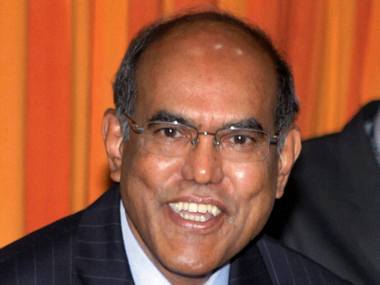The Reserve Bank of India has done it again. The twelfth rate hike in 18 months, this time of 25 basis points. The markets seem to have already factored this in and did not display any major jitters after the hike was announced.
But what is important to note is the fact that the central bank continues to accord top priority to inflation management, and has firmly put growth second in its list.
[caption id=“attachment_85886” align=“alignleft” width=“380” caption=“The RBI governor D Subbarao. PTI”]  [/caption]
After 11 straight hikes in key rates, the latest inflation numbers which came in on Wednesday still put headline year-on-year WPI inflation at 9.8 percent in August, up from the previous month’s figure of 9.2 percent. Even when the July figures came in, analysts have been betting on a rate hike in September, since the figure was still above 9 percent.
The growth figures, however, are a clear indicator that the previous rate hikes, and the challenging economic situation globally, has begun to have its effect. This is also acknowledged by the finance ministry with some officials pitching in in favour of a pause now.
It is also amply clear from the central bank’s statements that RBI mandarins are seized of the threats posed by the overall global situation, but are choosing to give top billing to inflation even now, despite the obvious impact of further rate actions on growth.
The RBI said in its 16 September statement: “…developments in the global economy over the past few weeks are a matter of serious concern. Growth momentum is weakening in the advanced economies amidst heightened concerns that recovery may take longer than expected earlier. Although India’s exports have performed extremely well in the recent period, this trend is unlikely to be sustained in the face of weakening global demand.”
With 11 rate hikes still failing to keep inflation at manageable levels, the RBI still maintains a rather hawkish tone in its policy statement for 16 September. It believes the rate actions of the past have succeeded in “containing inflation and anchoring inflationary expectations”, though it adds immediately that both remain “at levels beyond the Reserve Bank’s comfort zone”.
This suggests that we may not still be done with rate hikes, particularly if the inflation numbers in the next couple of months continue to be a cause for worry. However, the central bank seeks to assuage concerns by saying that the effects of the past actions will now be felt towards the second half of 2011-12, and the inflation trajectory may actually be reversed.
The RBI also justifies its action by saying that a premature change in policy stance could harden inflationary expectations once again and nullify the impact of past rate hikes.
It is this singular focus on inflation management which has now begun worrying analysts and industry alike. Taken together with the fuel price hike announced on 15 September and the poor IIP numbers, the RBI stance will seem to some as excessively inflation-centric, particularly in the context of a brewing global crisis with the United States and the eurozone at the epicentre.
The latest rate action will doubtless start pinching corporate India seriously as demand is already constrained. Investment plans will have to be revisited and redrawn.
At what point will RBI give growth top billing once again? Industry will be hoping that it is not too late. If there was a signal the central bank sought to give from this policy statement, it has been a pretty alarming one.


)
)
)
)
)
)
)
)
)



